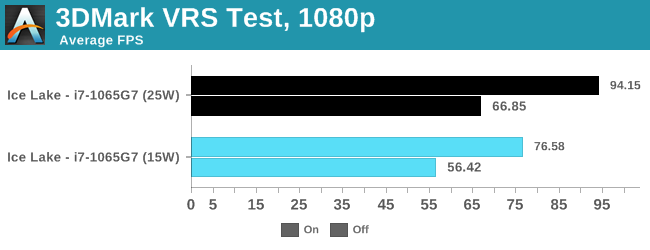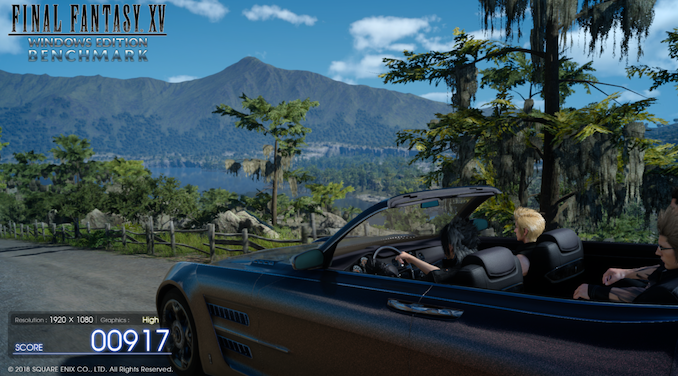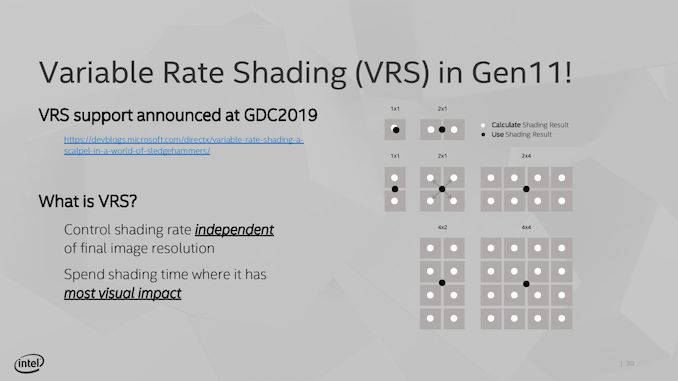The Ice Lake Benchmark Preview: Inside Intel's 10nm
by Dr. Ian Cutress on August 1, 2019 9:00 AM EST- Posted in
- CPUs
- Intel
- GPUs
- 10nm
- Core
- Ice Lake
- Cannon Lake
- Sunny Cove
- 10th Gen Core
Gaming Results (15W and 25W)
One of the biggest changes to the Ice Lake design is in the integrated graphics – Intel is now giving more focus and more die area to graphics, something it has arguably been neglecting for several years now. With Ice Lake, we move to a Gen11 graphics architecture, which is almost like the previous Gen9.5 but now with added support for variable rate shading (VRS), moving from 24 EUs to 64 EUs, and memory support up from LPDDR3-2133 to LPDDR4X-3733.


World of Tanks is a very CPU driven benchmark, and having the extra frequency of the 25W processor does help here. We're getting a sizeable uplift from Whiskey Lake, due to the extra EUs and memory frequency.


Our Final Fantasy test seemed to regress in 25W mode, although still within the noise. This test is still GPU bound, so adding the extra TDP to the CPU didn't actually help much. However, comparing to the Whiskey Lake integrated graphics, we've got over a 2x speedup.


Similarly with Civilization, with what is normally our 'IGP' settings, we are still GPU limited here.
One of Intel's newest features is Variable Rate Shading.
If developers add the option, soon to be an easy checkbox in Unity and Unreal, the game can decide to control the rate at which it shades pixels, from calculating every pixel down using one result across a 4x4 grid, to save compute power. Currently the only way to test this is with the 3DMark functional demo.

The new VRS test in 3DMark is designed as a feature test to show the potential uplift effect from enabling variable rate shading within a game. In both 15W and 25W modes, the data saw a good uplift, and we seemed to get more out of the 25W mode than the 15W mode.














261 Comments
View All Comments
unclevagz - Thursday, August 1, 2019 - link
I am assuming that Ice lake-Us aren't all i7s, because that's what the first page table is listing.Also, when you have more time, would it be possible to put spec2k6/2k17 test results of other processors at 3.9ghz for a more direct IPC comparison? Not to mention it'd be nice to list results from mobile SoCs (A12, SD855 etc) just for reference as well.
Ryan Smith - Thursday, August 1, 2019 - link
Thanks!DanNeely - Thursday, August 1, 2019 - link
The first table of CPUs lists all the models as i7, not i7/5/3 as described in the article text.ToTTenTranz - Thursday, August 1, 2019 - link
Is it my impression or the 15-25W TDP switch is only affecting the CPU power budget while leaving the GPU intact?It's making no difference in gaming workloads except for the WoW benchmark, where at >200 FPS we're clearly looking at a CPU-limited scenario.
What's VRS? The Variable Rate Shading test from 3dmark? Could that somehow be CPU-limited too?
Ian Cutress - Thursday, August 1, 2019 - link
Correct on the CPU budget.For variable rate shading, see here: https://www.anandtech.com/show/14514/examining-int...
I'll update the article too
ToTTenTranz - Thursday, August 1, 2019 - link
Thanks for the response Ian.Did you ask them if this is something Intel will tweaking this further?
It seems that the 25W mode is leaving a lot of GPU performance on the table, and in GPU-intensive tasks they'd gain a lot more by keeping the CPU power budget intact while providing more headroom for higher clocks on the GPU.
This would be akin to what AMD is doing with mobile Raven Ridge and Picasso, but Intel has a major bandwidth advantage here.
Ian Cutress - Thursday, August 1, 2019 - link
I'm not sure how well the GPU clocks if you push the power. We haven't seen many Intel mobile IGPs go above 1100/1150 in quite a while. I wonder if there's a limit there, or simply Intel needed a minimum CPU performance and whatever was left went to the GPU.Lots of ways to slice it. Only Intel knows for sure.
eastcoast_pete - Thursday, August 1, 2019 - link
Plus, the iGPU will likely run into the speed limitations of having to use system RAM. Not sure how far one has to push the 64 EUs before they start to do the silicon equivalent of twiddling their thumbs waiting for the memory. Might be an interesting thing to test once Ice Lake is released into the wild.0ldman79 - Friday, August 2, 2019 - link
I'd like to see a comparison of the iGPU vs the Gen9 iGPU.It's more powerful per EU and there are a little over twice as many EU vs the previous models. That being said, the 530 was decent, I could play games at 720P low settings with decent framerates, but even at 3 times the performance that's still not enough to play those games at 1080p.
SoulShadow - Thursday, August 1, 2019 - link
How does Ice Lake look with an eGPU setup? Is it still going to be mediocre?Been thinking about dumping my Ryzen 7 1700 desktop and tossing the 1080ti into an eGPU enclosure with a laptop.
Would be far more convenient I'm just concerned about bad performance loss from moving to a 25/45w cpu